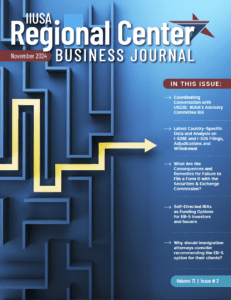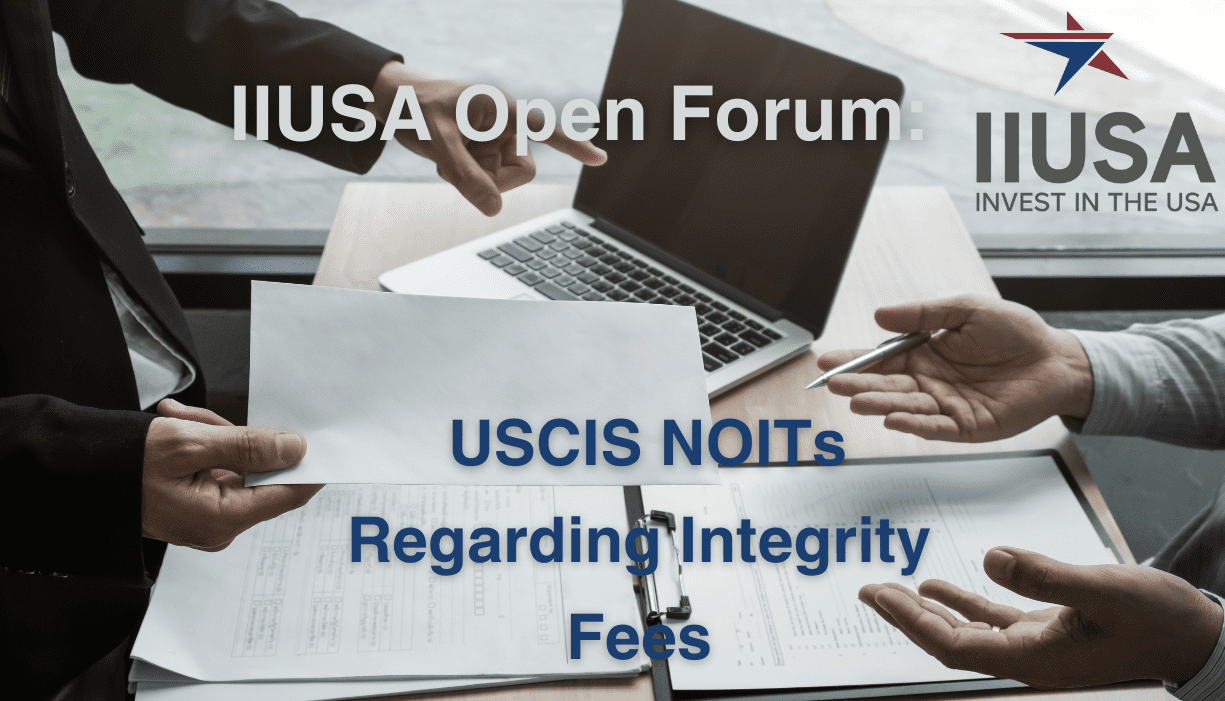EB-5 Integrity Fund NOITs: What Should You Do?
By D. Simone Williams, Partner, Williams Global Law
IIUSA members had access to an exclusive, in-depth, members-only webinar on this topic. If you are not an IIUSA member and you would like access to benefits like this (and many more), contact quinton.lewis@iiusa.org or apply for membership today.
The information in this article is for information purposes only and is not legal advice. If you have questions on this topic, contact your legal counsel.
Has your regional center received a Notice of Intent to Terminate (NOIT) with little to no option for recourse and a tight deadline? Trust me, you are not alone.
It appears that the United States Citizenship and Immigration Services (USCIS) issued a slew of NOITs to regional centers that failed to pay the annual EB-5 integrity fees. The situation is quite complicated. IIUSA has been discussing remedies both online and offline.
For better assessment of the overall situation, IIUSA is collecting data from regional centers. If you or your client received a NOIT regarding the annual integrity fee, please fill out this simple Google Form[1]. The data collected from this form is critical for IIUSA to engage in meaningful advocacy for this immediate issue and to help set standards for the way USCIS navigates the EB-5 integrity fund in the future.
While IIUSA advocacy is a critical element in the overall solution, each regional center has an individual responsibility as well. On Thursday, July 18, IIUSA held a webinar titled, IIUSA Open Forum: USCIS NOITs Regarding Integrity Fees to help regional centers figure out options for their next steps.
The panel was moderated President of IIUSA and EB-5 New York State, Bill Gresser. Expert panelists included:
- Ron Klasko, Managing Partner of Klasko Immigration Law Partners
- Carolyn Lee, Founder of Carolyn Lee PLLC
- Dan Lundy, Member of CSG Law Immigration Group
- John P. Pratt, Partner of Kurzban Tetzeli & Pratt and Director of IIUSA
These EB-5 experts were joined by a community of attorneys, regional center operators, and financial experts who have all been impacted by the recent rush of NOITs in the EB-5 universe.To break this down simply, we will answer three (3) questions:
- What should you do?
- Why is this happening?
- What are the possible outcomes?
What Should You Do?
RESPOND, RESPOND, RESPOND! Not only should you timely respond to the NOIT, but you should also provide a factual and strong legal argument. During the panel, experts agreed that a simple plea for forgiveness with a check attached may not suffice. In fact, many panelists opined that sending a check with the payments may cause USCIS to return the mailed response, leading to an untimely submission determination. Instead, panelists leaned heavily on the need to submit factual and legal arguments.
First, IIUSA panelists encourages each regional center to provide factual arguments. Did your regional center miss both payments? Did it pay only one? Was your regional center waiting to receive approval for designation? Answer those questions factually.
Then, present your legal argument. Overwhelmingly, many will agree that USCIS language led to confusion. From changing due dates to vagueness about which fiscal year needed to be accounted for, one can derive a legal argument about the lack of clarity on an issue that would lead to mandatory termination. Additionally, experts in the session discussed that USCIS did not provide an option for remedy. Normally, USCIS would issue a Notice of Intent to Suspend or send correspondence up to 90 days after the due date to allow regional centers a timely remedy. Many attorneys will suggest an option for regional centers to pay integrity fees for both fiscal years and a late penalty fee offered to regional centers. Lastly, experts pointed out that USCIS has already used their discretion to extend the deadline in May 2023. Therefore, it is within the scope of their power to extend the deadline again to accommodate the hundreds of regional centers facing this issue.
Ultimately, each regional center and their counsel must look at their specific situation to determine the best legal arguments.
Another important question arises: Should regional centers tell investors about the risk of termination?
Panelists were undecided on this point. If regional centers are actively raising funds, it is best to put fundraising procedures on pause as this uncertain process continues.
Whether or not regional centers should notify investors about the potential failures has not been conclusively decided. Regional centers should defer to their securities counsel for legal requirements to inform investors about this development. Certainly, investors want the opportunity to decide their next best step. If you are an investor reading this, ask your regional center if they have received a Notice of Intent to Terminate (NOIT) and how they plan to respond. Many regional centers have until the end of July to respond. Additionally, investors and regional centers should contact their EB-5 immigration attorneys to discuss the possibility of invoking the Good Faith Investor Provisions. The Good Faith Investor Provisions were set in place to protect investors in the case of terminations based on purely administrative noncompliance.
Why is This Happening?
Many did not understand that two integrity fees were supposed to be paid in 2023. As many of you know, President Joe Biden signed the EB-5 Reform and Integrity Act of 2022 (“RIA”) over two years ago. The RIA established a special fund known as the EB-5 Integrity Fund.[2] This fund would be financed by collecting an annual fee from each designated regional center.[3] On March 2, 2023, USCIS posted a Federal Register notice explaining that the first fee must be paid by April 1, 2023. In an admission that, “information about the due dates and penalties might not have been clear,” USCIS extended the due date to October 1, 2023. USCIS also asserted that further integrity fee payments must be made before October 31 of every year.
The series of announcements and moving due dates led to a lot of confusion from regional centers. Regional centers had to pay the FY 2023 integrity fee and the FY 2024 fee by October 31, 2023. Ultimately, USCIS’s effort to accumulate the integrity fees for the current and upcoming fiscal year resulted in a critical distinction slipping through the cracks.
Now we see just how critical this distinction was. USCIS declared that it would take steps to terminate any regional center that did not pay the required EB-5 Integrity Fund fees for FY 2023 and FY 2024 within at 90 days of the October 31 due date. According to USCIS, regional centers who received NOITs will be terminated unless they can show that they paid both integrity fees.
What Are the Possible Outcomes?
Every regional center must accept the possibility of termination. This is an unprecedented situation, even for USCIS; however, it is possible that USCIS will double down on their decision to terminate despite the responses from regional centers.
It is also possible that the sheer number of responses from regional centers that want to continue despite not paying the integrity fees will cause USCIS to provide an out. However, we must acknowledge that USCIS knows exactly how many NOITs it sent out. The hope is that USCIS underestimated how many regional centers were confused by the language in the Federal Register and subsequent announcements. If USCIS does provide an out for regional centers, it may come in the form of a short extension period and a penalty fee.
If USCIS issues sweeping terminations, each regional center has a right to appeal to the Administrative Appeals Office (“AAO”) within thirty (30) days. In this case, a regional center is not technically terminated until it loses at the AAO. This may allow the regional center to stay in business for up to one year, depending on the duration of the AAO appeal. This option may protect investors as they figure out their options. The RIA requires appeals to go through the AAO before it is brought to Federal Court. If a regional center tries to skip the AAO and go straight to Federal Court, they risk a loss by failing to exhaust all administration options for remedy. Even in cases where litigation has grounds that the AAO cannot deal with, most panelists agreed that going through AAO first is the safest route.
While each regional center is responding individually, IIUSA is actively advocating to the Office of the Citizenship and Immigration Services Ombudsman (CIS Ombudsman) which serves as a liaison between the public and USCIS[4].
In either of these cases, IIUSA will need to continue collecting data from regional centers. Please fill out this form to help IIUSA advocate on behalf of regional centers and investors nationwide.
And remember: RESPOND! RESPOND! RESPOND!
For more information, view the USCIS EB-5 Integrity Fund page.
[1] https://docs.google.com/forms/d/e/1FAIpQLSfpB8BV30sxXrZz1J32-DCY0C9-l92Id_X_54Lm6wsFTkUvXQ/viewform
[2] https://www.uscis.gov/IntegrityFund
[3] https://www.uscis.gov/IntegrityFund
[4] https://www.dhs.gov/topics/cis-ombudsman
[5] https://docs.google.com/forms/d/e/1FAIpQLSfpB8BV30sxXrZz1J32-DCY0C9-l92Id_X_54Lm6wsFTkUvXQ/viewform








